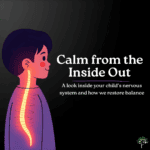How Nervous System Scans Reveal What Traditional Approaches Often Miss
For many families, the journey to help a child who is struggling—whether with focus, anxiety, sensory overload, sleep, digestion, or behavior—can feel like an endless maze. You try therapy. You try diet changes. You try new routines. You try everything you’re told should work…
Yet progress is slow. Or inconsistent. Or feels like one step forward, two steps back.
This is the moment when parents often walk into Vital Wellness Center and say the same seven words:
“We’ve tried everything. Nothing seems to stick.”
And what we’ve found, time and time again, is that the missing piece isn’t more therapy, or more discipline, or more structure.
The missing piece is the nervous system—the foundation that all therapies depend on.
Why Therapies Don’t “Stick” When the Nervous System Is Dysregulated
Occupational therapy, speech therapy, counseling, physical therapy, behavioral interventions—they all work on top of the nervous system.
If that system is stuck in a stressed, overwhelmed, or dysregulated state, the brain simply cannot process, learn, or adapt in the way therapies intend.
It’s not that the child won’t focus.
Their nervous system can’t focus.
It’s not that they refuse to calm down.
Their brain is stuck in fight-or-flight.
It’s not that they’re “behind.”
They haven’t been able to access the parts of the brain that help them develop and thrive.
When a nervous system is overloaded or underperforming, the body prioritizes survival—not growth, not language, not emotional regulation, not attention.
That’s why so many kids work so hard in therapy but still plateau.
The Role of Insight Scans: Seeing the Root Cause Clearly
At Vital Wellness Center, we don’t guess.
We measure.
Our Insight Scans show three major components of nervous system function:
- sEMG (Surface EMG)
Reveals how much tension the muscles along the spine are holding.
Kids stuck in fight-or-flight often show elevated, chaotic patterns. - Thermal Scan
Shows how well the nerves that regulate organs and systems are communicating.
Digestive issues, sleep problems, immune challenges, and mood instability often show up here long before symptoms start. - HRV (Heart Rate Variability)
Measures adaptability—the nervous system’s ability to shift between stress and calm.
Low HRV is a hallmark sign of dysregulation.
When these scans show stress, imbalance, or lack of adaptability, the brain simply isn’t ready to learn, engage, or regulate.
Therapies may help, but the progress won’t last because the foundation isn’t stable.
Why Chiropractic Care Complements (Not Replaces) Therapy
Chiropractic adjustments don’t “fix” speech delays.
They don’t “cure” anxiety.
They don’t directly teach motor skills or behavior.
They restore balance and communication in the nervous system—so therapy can finally work the way it’s meant to.
Chiropractic helps by:
- Reducing stored tension in the spine and muscles
- Improving brain-body communication
- Calming an overactive fight-or-flight system
- Boosting focus, adaptability, and regulation
- Opening the door for learning, emotional control, and development
When the nervous system becomes more organized, children often begin to:
- Sit longer during therapy sessions
- Follow instructions more easily
- Regulate emotions more consistently
- Sleep better
- Feel less overwhelmed by sensory input
- Show faster and more lasting improvements
Therapists regularly tell parents, “Whatever you’re doing… keep doing it.”
Because now the brain is ready.
Real-Life Example: When Everything Shifted
We see this pattern constantly:
A child has been doing OT or speech for months, even years. Progress is slow. Meltdowns are frequent. Transitions are hard. Focus is unpredictable.
After a neurological exam and scans at VWC, we find:
- High stress patterns along the spine
- Low HRV (poor adaptability)
- Thermal imbalance connected to sleep or digestion
Within weeks of gentle pediatric adjustments, parents often report:
“Therapy is finally working.”
“He’s calmer and more focused.”
“She isn’t melting down as much.”
“He’s actually retaining what he learns.”
“She’s making leaps we haven’t seen before.”
Not because the therapy changed…
but because the nervous system did.
Why Parents Call Chiropractic the “Missing Piece”
When you calm the brainstem…
When you improve communication through the spine…
When you help the body adapt instead of react…
Everything else begins to work better.
The child becomes teachable.
The brain becomes flexible.
The body becomes resilient.
Therapy starts to stick.
If You’ve Been Doing Everything “Right” but Feel Stuck…
It’s not your fault.
It’s not your child’s fault.
And you’re not missing some magic therapy you haven’t heard about yet.
You’re likely missing the one thing that sits beneath all therapies:
A calm, coordinated, adaptable nervous system.
At Vital Wellness Center, we specialize in identifying nervous system stress and guiding kids—from toddlers to teens—into a healthier, more regulated state so therapy, school, and everyday life become easier.
If you’re curious whether your child’s nervous system is the missing piece, our team can help you get clear answers.
Start with a simple neurological exam and Insight Scan.
It’s where real breakthroughs begin.



